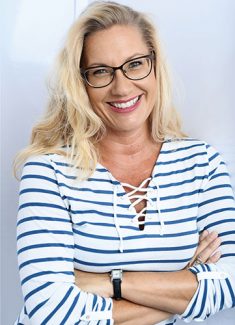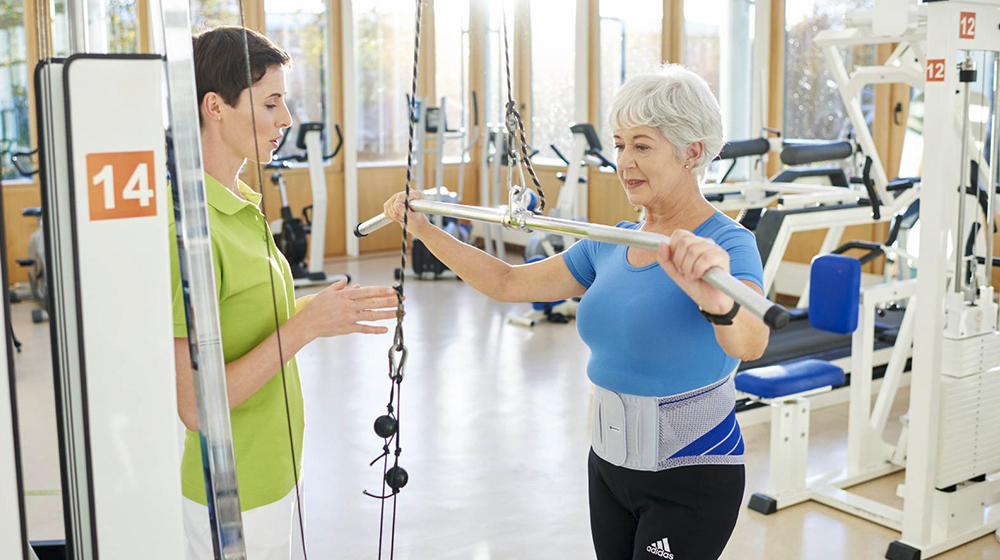Artikkel hentet fra Bauerfeind Life magazine
“We want to bring the muscles back into play”
Listening, examining, treating – each of these steps has to be performed thoroughly. The recipe for success of orthopedic specialist Susanne Gramatté at the Berlin Pain Center in Germany is rather straightforward. The physician relies on a combination of physiotherapy and supports or orthoses for the non-surgical treatment of her patients suffering from back pain.

Susanne Gramatté, orthopedic specialist at the Berlin Pain Center.
What is your view of non-specific back pain?
Susanne Gramatté: It is a controversial diagnosis that I’m not happy with. It often prevents a thorough examination of the patient. Low back pain can have various causes. My aspiration is to find these root causes. Where does this functional problem come from if there is no structural damage? I often see misalignments in the neck, head or jaw as causes, or the muscles are not orthograde and resemble a wrung out towel. Amidst all these observations and the search for the cause, patients suffering from back pain are desperate to achieve one thing: to escape the pain.
How do you achieve this?
Susanne Gramatté: Depending on the specific case, I use supports and orthoses, as well as drug-based or manual therapy to minimize the inhibiting pain. This needs to be achieved first for the patient to be ready to commit to further treatment steps, and this also includes physiotherapy, of course. I can remember a patient suffering from SI joint syndrome who took very small steps. Her body’s center of gravity had shifted and her deep supporting muscles were in a poor condition. The pelvis was tilted forwards, causing permanent tension on her muscles. She felt she was going to break apart. After I had examined her, I prescribed an aid. When the patient left the medical supply retailer, she was like a different person. And this was thanks to a SacroLoc for stabilizing the pelvis.
What is your process for finding a suitable treatment?
Susanne Gramatté: The first step is always a detailed look at the medical history. I listen. I examine. It is astonishingly common that patients are surprised when I ask them to remove items of clothing. Some colleagues seem to find MRI findings and a look at the gait sufficient. But I never make a diagnosis through trousers. I examine my patients when standing up, sitting and lying down. This allows me to address different muscle groups that might otherwise disguise an incorrect posture. Where and when does the pain occur? Where does it radiate to? What makes it worse? Once I know these things, I get an idea of whether I can work with physiotherapy, possibly combined with orthopedic aids.
Are you talking about physiotherapy exercises performed while wearing a support or orthosis?
Susanne Gramatté: If an orthosis provides relief for the pelvis and it is back in its normal position, the patient is able to exercise relatively pain-free. Aids and physiotherapy can complement each other. Exercises that are suitable for this combination are shown on the new treatment app for the back. They were developed by physicians, including myself, in cooperation with physiotherapists. Circular compression can reduce tension on the muscle insertion. This enables the muscles we really want to work with to come back into play.
“Depending on the specific case, I use supports and orthoses (…) to minimize the inhibiting pain.”
Susanne Gramatté
Which back supports are compatible with physiotherapy?
Susanne Gramatté: The LumboTrain for example allows for plenty of freedom of movement for physiotherapy exercises. Its stabilizing effect is not quite as strong as that of the SacroLoc, but it is sufficient , for example, for providing relief in the case of myogelosis in the lumbar extensors. In addition to this, the LumboTrain activates other muscle groups via proprioception, which in turn provides for a gentle stimulation of the muscles that were previously affected by myogelosis. It also reduces lordosis slightly, and it can therefore initiate a straightening of the lumbar spine area. The patient is able to breathe deeply again and to feel stable. And this feeling of stability enables patients to let go and to allow their muscles to build up. However, there is one important requirement: the irritated area must be put at ease. For this purpose I occasionally use an orthosis for the lumbar spine, the LordoLoc – for example in the case of pain that radiates upwards towards the thoracic spine.
How do you involve the physiotherapists in the process?
Susanne Gramatté: If I have a particular treatment chain in mind, I sometimes attach a corresponding Post-it note to the prescription. Feedback from physiotherapists has been rather positive in these cases. They receive more information about the patient’s problem. If a back support or orthosis is being used, they can usually expect a patient they can work with, whose range of movement is on a normal , stable level. A stable center is essential. It will otherwise be hard to compensate for missteps in everyday life.
Story Check
Susanne Gramatté from Schmerzzentrum Berlin also treats patients using combination therapy.
- Orthopedic aids and physiotherapy complement each other.
- Thanks to their pain and strain reducing effects, supports and orthoses often create the basic conditions required for physiotherapy.
- Back exercises with supports and orthoses that supplement the treatment are shown in the new Bauerfeind treatment app.
Images: Bauerfeind, private
Du kan lese hele artikkelen på: https://www.bauerfeind-life.com/en/back-pain-therapy-interview-susanne-gramatte/
Ta gjerne kontakt så forteller vi mer om Bauerfeind produktene på post@ortopro.no

